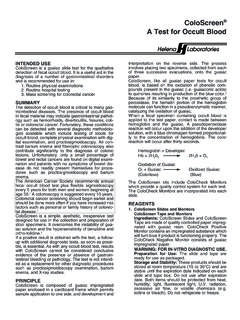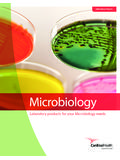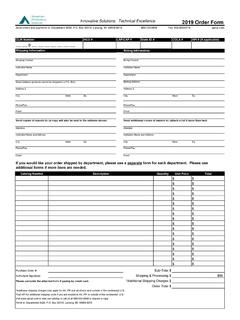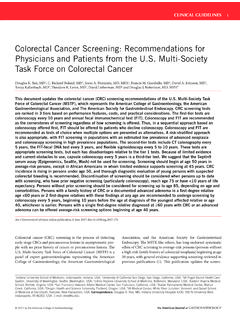Transcription of PROCEDURE Ecotest FOB-F23 Faecal Occult Blood …
1 INTENDED USE The FOB rapid Test Device ( feces ) is a rapid visual immunoassay for the qualitative, presumptive detection of human hemoglobin in human fecal specimens. This kit is intended for use as an aid in the diagnosis of lower gastrointestinal ( ) pathologies. INTRODUCTION Colorectal cancer is one of the most commonly diagnosed cancers and a leading cause of cancer-related death in the United States. Screening for colorectal cancer is likely to improve the odds of detecting cancer at an early stage, reducing mortality. Earlier commercially available FOB tests utilized a guaiac test, requiring special dietary restrictions to minimize false positive and false negative results. The FOB rapid Test Device ( feces ) is designed especially to detect human hemoglobin in fecal samples using immunochemical methods, improving specificity for the detection of lower gastrointestinal disorders, including colorectal cancers and adenomas, without the need for dietary restrictions.
2 PRINCIPLE The FOB rapid Test Device ( feces ) detects human hemoglobin through visual interpretation of color development on the internal strip. Anti-human hemoglobin antibodies are immobilized on the test region of the membrane. During testing, the specimen reacts with anti-human hemoglobin antibodies conjugated to colored particles and precoated onto the sample pad of the test. The mixture then migrates through the membrane by capillary action and interacts with reagents on the membrane. If there is sufficient human hemoglobin in the specimen, a colored band will form at the test region of the membrane. The presence of this colored band indicates a positive result, while its absence indicates a negative result.
3 The appearance of a colored band at the control region serves as a procedural control, indicating that the proper volume of specimen has been added and membrane wicking has occurred. MATERIALS Materials Provided Test devices Package insert Specimen dilution tubes wit h buffer Materials Required but Not provided Timer Specimen collection container PRECAUTIONS For professional in vitro diagnostic use only. Do not use after the expiration date indicated on the package. Do not use the test if the foil pouch is damaged. Do not reuse tests . This kit contains products of animal origin. Certified knowledge of the origin and/or sanitary state of the animals does not completely guarantee the absence of transmissible pathogenic agents.
4 It is therefore recommended that these products be treated as potentially infectious and handled by observing usual safety precautions ( , do not ingest or inhale). Avo id cross-contamination of specimens by using a new specimen collection container for each specimen obtained. Read the entire PROCEDURE carefully prior to testing Do not eat, drink or smoke in any area where specimens and kits are handled. Handle all specimens as if they contain infectious agents. Observe established precautions against microbiological hazards throughout the PROCEDURE and follow standard procedures for the proper disposal of specimens. Wear protective clothing such as laboratory coats, disposable gloves and eye protection when specimens are assayed.
5 The specimen dilution buffer contains sodium azide which may react with lead or copper plumbing to form potentially explosive metal azides. When disposing of the specimen dilution buffer or extracted samples, always flush with copious quantities of water to prevent azide buildup. Do not interchange or mix reagents from different lots. Humidity and temperature can adversely affect results. Used testing materials should be discarded according to local regulations. STORAGE AND STABILITY The kit should be stored at 2-30 C until the expiry date printed on the sealed pouch. The test must remain in the sealed pouch until use. Do not freeze. Care should be taken to protect the components of this kit from contamination. Do not use if there is evidence of microbial contamination or precipitation.
6 Biological contamination of dispensing equipment, containers or reagents can lead to false results. SPECIMEN COLLECTION AND STORAGE The FOB rapid Test Device ( feces ) is intended for use with human fecal specimens only. Patients should not collect samples during or within 3 days of their menstrual period if they have bleeding hemorrhoids, Blood in the urine, or if they experienced strain during their bowel movement. Alcohol, aspirin and other medications taken in excess may cause gastrointestinal irritation resulting in Occult bleeding. Such substances should be discontinued at least 48 hours prior to testing. No dietary restrictions are necessary before testing. Perform testing immediately after specimen collection.
7 Do not leave specimens at room temperature for prolonged periods. Specimens may be stored at 2-8 C for up to 72 hours. Bring specimens to room temperature prior to testing. If specimens are to be shipped, pack them in compliance with all applicable regulations for transportation of etio logical agents. PROCEDURE Bring tests , specimens, buffer and/or controls to room temperature (15-30 C) before use. 1. Specimen collection and pre-treatment: 1) Unscrew and remove the dilution tube applicator. Be careful not to spill or spatter solution from the tube. Collect specimens by inserting the applicator stick into at least 3 different sites of the feces . 2) Replace the applicator back into the tube and screw the cap tightly. Be careful not to break the tip of the dilution tube.
8 3) Shake the specimen collection tube vigorously to mix the specimen and extraction buffer. Specimens prepared in the specimen collection tube may be stored for 6 months at -20 C if not tested within 1 hour after preparation. 2. Testing 1) Remove the test from its sealed pouch, and place it on a clean, level surface. Label the test with patient or control identification. For best results, the assay should be performed within one hour. 2) Using a piece of tissue paper, break the tip of the dilution tube. Hold the tube vertically and dispense 3 drops of solution into the specimen well (S) of the test device. Avoid trapping air bubbles in the specimen well (S), and do not add any solution to the result area.
9 As the test begins to work, color will migrate across the membrane. 3. Wait for the colored band(s) to appear. The result should be read at 5 minutes. Do not interpret the result after 10 INTERPRETATION OF RESULTS POSITIVE: Two colored bands appear on the membrane. One band appears in the control region (C) and another band appears in the test region (T). NEGATIVE: Only one colored band appears, in the control region (C). No apparent colored band appears in the test region (T). INVALID: Control band fails to appear. Results from any test which has not produced a control band at the specified read time must be discarded. Please review the PROCEDURE and repeat with a new test. If the problem persists, discontinue using the kit immediately and contact your local distributor.
10 NOTE: 1. The intensity of color in the test region (T) may vary depending on the concentration of analytes present in the specimen. Therefore, any shade of color in the test region should be considered positive. Note that this is a qualitative test only, and cannot determine the concentration of analytes in the specimen. 2. Insufficient specimen volume, incorrect operating PROCEDURE or expired tests are the most likely reasons for control band failure. QUALITY CONTROL Internal procedural controls are included in the test. A colored band appearing in the control region (C) is considered an internal positive procedural control, confirming sufficient specimen volume and correct procedural technique. External controls are not supplied with this kit.




